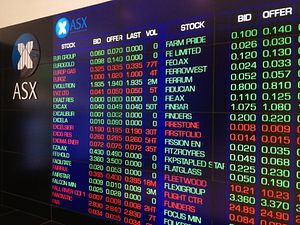Australians aged under 21 have yet to know recession. The prospects of this continuing longer have gained a boost after the release of stronger than expected economic growth data, with both stocks and the local currency rallying.
On Wednesday, the Australian Bureau of Statistics (ABS) announced that the world’s 12th largest economy expanded by 0.8 percent in the December quarter, or 2.8 percent on an annualized basis. While below the long-term average of 3 percent growth, the December rise was the fastest in a year, helped by growing exports, a weaker currency and continuing record-low interest rates.
The rise in gross domestic product (GDP) beat economists’ expectations of a 0.7 percent increase for the quarter, with the main surprise being a solid 0.8 percent gain in household spending.
The improved data also reflected stronger dwelling investment, helped by Sydney’s surging housing market, while exports rose 2.4 percent in the quarter as the trade balance shifted into surplus. New private business investment actually declined 3.4 percent, with the winding down of the mining boom expected to further weaken business spending.
The news helped Australian stocks close at their highest level in more than 5 ½ years, with the benchmark S&P/ASX200 index ending at 5,446. The Australian dollar also benefited, with traders pushing the currency higher for a third straight day on speculation of an end to further interest rate cuts by the central bank, although the dollar remained 13 percent weaker than a year ago.
Commenting on the data, ANZ economists said in a March 5 research note that “growth looks to be below trend, although there are some positive signs emerging. While the windback in mining investment expected over the next couple of years will weigh on growth, there are early signs that other sectors of the economy are starting to pick up: housing investment is set to pick up strongly this year, household consumption is trending higher, and the outlook for non-mining investment looks to be improving.”
Australian Treasurer Joe Hockey was less enthusiastic however, warning of harder times ahead.
“Today’s numbers highlight the growth challenge that the economy will face in the next couple of years as construction on a number of large mining projects comes to an end,” he said in a statement.
“The Coalition’s plan to reduce regulation and abolish taxes will help smooth the transition in the economy away from resource investment and toward growth in the non-mining sectors. That will be key to boosting annual growth to more than 3 percent, which is what’s needed to bring unemployment down.”
Job Fears
Job cuts at manufacturers, engineering and mining companies and even the national flag carrier have highlighted the nation’s rising unemployment. In February, the official jobless rate reached 6 percent, its highest level since 2003, worse even than during the global financial crisis.
As previously reported by The Diplomat, Toyota Motor’s decision to join Ford and General Motors Holden and end vehicle manufacturing in Australia is expected to cost upwards of 50,000 jobs, while Qantas Airways announced last month it would slash 5,000 jobs in a bid to avoid further financial turbulence.
Opposition Leader Bill Shorten attacked the government over the jobless data, saying in a statement, “Before the election Mr Abbott promised Australians he would create one million jobs, but since September more than 63,000 people have joined the unemployment queue.”
Consumer confidence has dropped to levels last seen 18 months ago, with the ANZ-Roy Morgan Consumer Confidence survey released Tuesday noting the impact of job cuts by Toyota and Qantas.
On Wednesday, the federal treasurer said only higher GDP growth would keep the jobless rate in check.
“We need to do better. You need trend growth or better of 3 [or] 3.25 percent to start to get unemployment down,” he told ABC radio.
The Reserve Bank of Australia has also forecast higher joblessness, with the central bank leaving official interest rates steady Tuesday for the seventh straight month at a record low 2.5 percent.
“On present indications, the most prudent course is likely to be a period of stability in interest rates,” RBA governor Glenn Stevens said in a statement. He noted “reasonable prospects” of a pickup in global growth this year, with the Australian economy benefitting from higher consumer demand and construction, offset by weaker business and government investment.
Commenting on the latest GDP numbers, JP Morgan Australia chief economist Stephen Walters said they could have been worse.
“We expect a pretty benign post-mining investment boom adjustment, with growth lifting slowly towards 3 percent over the course of 2014,” he told AAP.
“Given the sheer size of the resources boom – more was invested in mining in Australia in the seven years to 2012 than in any other country – we should accept a period of sub-trend growth without complaint.”
For Walters and other economists though, the trillion-dollar question is when the “rotation” of growth from the mining to non-mining sectors starts to show its effects.
“Outside higher exports, the positive contributions last quarter from household spending, home construction and public spending [all higher] were wiped out by a big fall in private investment, leaving domestic demand all but flat,” he said. “Where’s the rotation?”
The last time the nation suffered the economic blues, Paul Keating was prime minister and boy band Boyz II Men had a hit single titled “The End of the Road.” Hockey and his government will be hoping it isn’t an omen.

































